Physical Address
304 North Cardinal St.
Dorchester Center, MA 02124
A large number of syndromes, dysplasias, and chromosomal anomalies are associated with congenital or acquired cardiac and vascular disease. This chapter discusses the cardiovascular features of some of the more commonly encountered lesions. A more extensive list is provided in Tables 78.1 to 78.3 later in this chapter.
The heterotaxy syndromes, comprising right and left isomerism, feature abnormalities of visceral/atrial laterality. These syndromes have an estimated incidence of 1 in 6,000 to 1 in 20,000 live births and account for 1% to 3% of all congenital heart defects. Although heterotaxy usually occurs sporadically, familial cases have been described, particularly an X-linked form. There is also an association between heterotaxy and gestational diabetes.
Body situs generally is divided into three types: solitus, inversus, and ambiguus. Situs solitus is the normal arrangement of the atria and viscera in the body (see Chapter 63 ). Situs inversus is the mirror image of normal; it is seen in 0.01% of the population and is associated with a slightly higher incidence of congenital heart disease (3%–5%) compared with the solitus population (0.6%–0.8%). Situs ambiguus, or heterotaxy, encompasses all other visceroatrial arrangements. By definition, in situs ambiguus, visceral malposition and dysmorphism associated with an indeterminate atrial arrangement is present. Abnormal body situs occurs frequently in association with ciliary dyskinesia, as these entities are thought to be linked by underlying fetal cilial dysfunction.
Heterotaxy syndrome with right isomerism or bilateral right-sidedness is usually, but not invariably, accompanied by asplenia. The condition is more common in males and is characterized by bilateral systemic atria with broad trabeculated appendages ( Fig. 78.1 ), bilateral trilobed lungs with bilateral minor fissures and short eparterial bronchi, a central horizontal liver, abnormal bowel rotation, and the stomach in an indeterminate position (see Fig. 78.1 ). The abdominal aorta and inferior vena cava often are located on the same side of the spine, frequently in a posterior-anterior orientation. Other occasional anomalies include tracheoesophageal fistula, imperforate anus, absent gallbladder, pancreatic anomalies, fused adrenal glands, and genitourinary abnormalities. The prognosis for right isomerism is often poor because of an abnormal immune status (asplenia) and the typically complex cardiac anomalies.
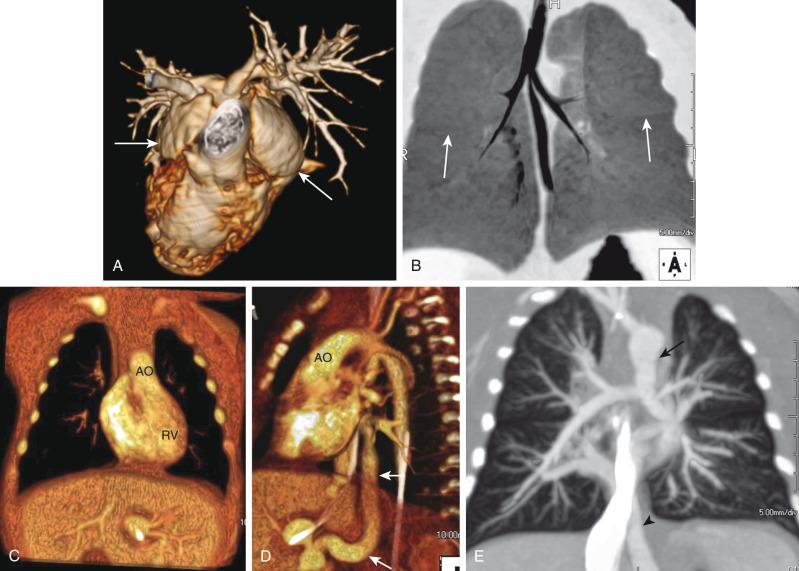
Cardiac anomalies are almost invariable and present with cyanosis and severe respiratory distress. The “right isomerism heart” often consists of a common atrioventricular canal, a single ventricle, a large ventricular septal defect (VSD), and a double-outlet right ventricle and/or transposition of the great vessels, along with pulmonary outflow obstruction or atresia and total anomalous pulmonary venous drainage (frequently obstructed) (see Fig. 78.1 ). The spectrum of cardiovascular anomalies also can include cardiac malposition (dextrocardia or mesocardia), tricuspid atresia, truncus arteriosus, right aortic arch, anomalous systemic venous return, and bilateral superior vena cavae.
Heterotaxy syndrome with left isomerism or bilateral left-sidedness most often accompanies polysplenia. It is characterized by bilateral pulmonary atria with narrow finger-like appendages, bilateral bilobed lungs, bilateral long hyparterial bronchi, a centrally located liver, the stomach in an indeterminate position, abnormal bowel rotation, and multiclefted or multiple spleens (either right sided or left sided) ( Fig. 78.2 ). An interrupted inferior vena cava with azygos continuation is the most consistent abdominal finding in left isomerism (see Fig. 78.2 ). Left isomerism is slightly more common in females and generally has a better prognosis than right isomerism with less complex cardiovascular disease. Other associated anomalies include ciliary dyskinesia, biliary atresia, pancreatic and other gastrointestinal abnormalities, and congenital portosystemic shunts (see Fig. 78.2 ).
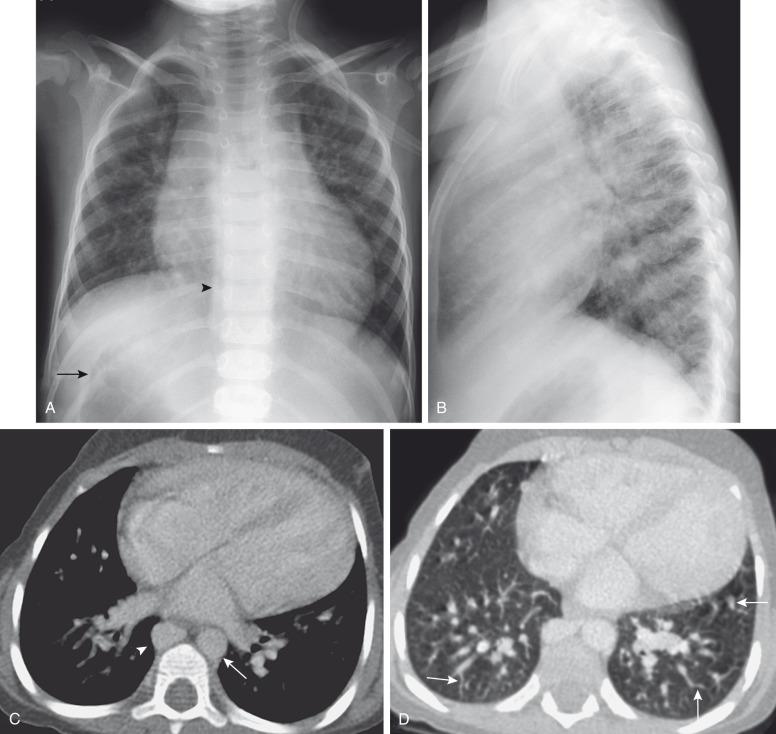
Cardiac anomalies are seen in more than 50% of patients who have heterotaxy syndrome with left isomerism. The common cardiovascular anomalies include abnormalities of the inferior and superior vena cavae, cardiac malposition, atrial septal defect (ASD), VSD, common atrioventricular canal, double-outlet right ventricle, and anomalous pulmonary venous return (usually partial).
Eight major structures are appraised to evaluate situs in heterotaxy syndromes :
Atrial morphology
Cardiac apex
Aortic position
Stomach and bowel position
Liver and gallbladder position
Spleen location and morphology
Abdominal venous drainage
Bronchial and pulmonary anatomy
Decreased pulmonary vascularity related to pulmonary outflow obstruction or pulmonary edema as a result of pulmonary venous obstruction is the most typical pattern seen on chest radiographs in persons with right isomerism. Cardiomegaly and increased vascularity on chest radiographs as a result of left-to-right shunting is the most common appearance in persons with left isomerism (see Fig. 78.2 ). Other chest radiographic features of the heterotaxy syndromes are related to duplicated structures, such as fissures and bronchi, as well as abnormal cardiac and visceral situs.
Echocardiography is the main imaging modality used to evaluate disordered intracardiac anatomy associated with heterotaxy. Both magnetic resonance imaging (MRI) and computed tomography (CT) have a role in fully defining this often complex anatomy. MRI, magnetic resonance angiography (MRA), and functional MRI assessment have partially replaced catheter-based angiography in evaluating these anomalies, especially the extracardiac vascular, airway, and visceral abnormalities (see Figs. 78.1 and 78.2 ).
Ultrasound is often the first step in evaluating the abdominal anatomy. An upper gastrointestinal study should be performed to evaluate for malrotation. A small bowel follow-through in conjunction with the upper gastrointestinal study may be helpful to determine the relative locations of the small and large bowel and to separate nonrotation from malrotation.
Ultrasound, CT, MRI, or liver-spleen scans using technetium-99m sulfur colloid or p-isopropylacetanilidoimidodiacetic acid are used to evaluate the presence and location of splenic tissue, to assess other organs/anomalies, and to help diagnose biliary atresia (associated with polysplenia). Multimodality imaging may be needed to elucidate other less common anomalies associated with heterotaxy such as a congenital portosystemic shunt and a hypoplastic or absent portal vein (Abernethy malformation) with consequent hyperammonemic encephalopathy or hepatopulmonary syndrome (associated with left isomerism; see Fig. 78.2 ).
Ehlers – Danlos syndrome (EDS) is an inherited group of connective tissue disorders affecting the skin, ligaments, joints, vasculature, and visceral organs. It is characterized by joint and skin hyperextensibility, excessive bruisability, blood vessel fragility, and poor wound healing. It occurs in as many as 1 in 5,000 individuals. Although EDS is incompletely understood, multiple distinct varieties of EDS have been recognized based on genetics, biochemical structure, and clinical presentation. The vascular or arterial ecchymotic type of EDS is the most clinically severe form. Mitral valve prolapse (MVP) is the most common cardiovascular anomaly; others include a dilated aortic root, aneurysm, and aortic dissection or rupture ( Fig. 78.3 ). Papillary muscle dysfunction or rupture and left ventricular rupture also can occur.
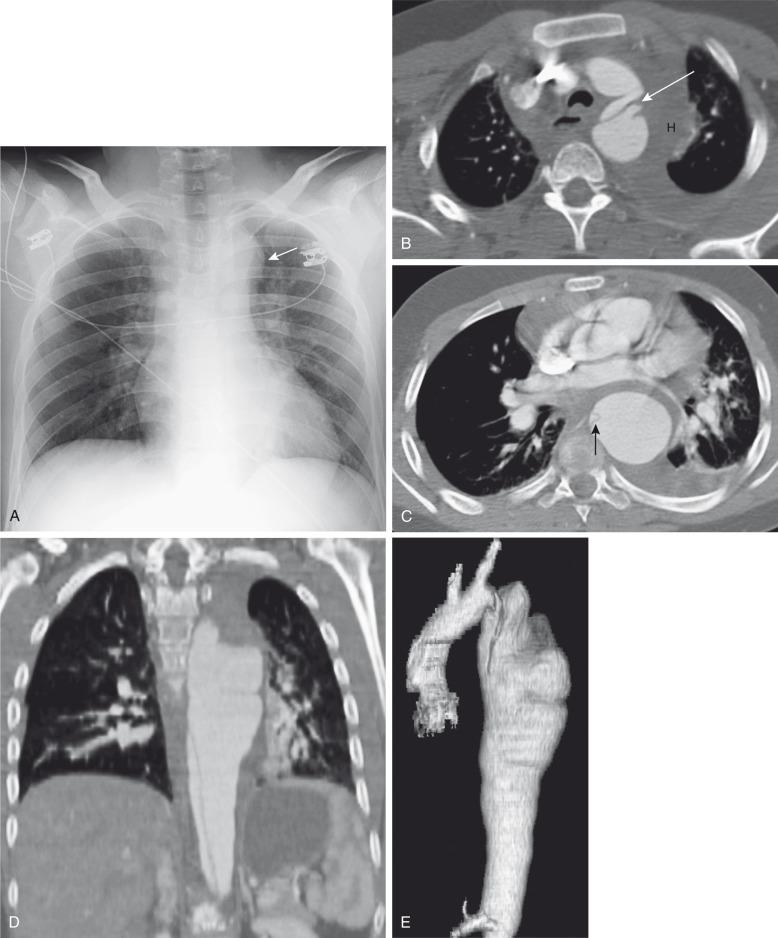
EDS is an autosomal dominant disorder caused by heterozygous mutations in the COL3A1 gene encoding type III collagen. More than 250 COL3A1 mutations have been identified. Patients are subject to spontaneous rupture of the bowel and other viscera. Vascular complications can occur either spontaneously or after minor trauma and include arteriovenous fistulas and aneurysms of the aorta and medium-sized arteries, with degeneration and subsequent rupture or dissection (see Fig. 78.3 ). The thoracic and abdominal arteries are involved in half of the cases, with extremity and head and neck vessels each contributing 25%. Neurovascular complications include carotid-cavernous fistula formation, carotid dissection, aneurysm formation, and rupture.
Echocardiography is the mainstay for evaluation of the heart and valvular function. Ultrasound, CT, and MRI are geared toward defining areas of aneurysm, dissection, and rupture. The size and the rate of growth of each aneurysm should be quantified. Because the neurovascular system may be involved, imaging of the cerebral circulation and the carotid arteries may be necessary.
The pattern of aneurysm distribution in persons with EDS differs from that in persons with Marfan syndrome. Whereas Marfan syndrome typically results in dilation of the aortic root and the sinuses of Valsalva, EDS produces discrete, fusiform aneurysms at different locations of the aorta, the iliac arteries, the cervical arteries, and their branches. Dissection in persons with EDS often has a complex morphology (see Fig. 78.3 ). The abnormal vessels usually are well characterized by noninvasive computed tomography angiography (CTA) and MRA. Catheter-based angiography carries significant hazards in these patients, with a reported complication rate of 67%. Because of the fragility of the vascular wall, elective surgery is generally discouraged with conservative management favored. Treatment with the beta-blocker celiprolol has been shown to reduce the risk of vascular events in patients with EDS.
Marfan syndrome is an autosomal dominant disorder of connective tissue caused by mutations in the FBN1 gene that codes for the extracellular matrix protein fibrillin-1. Marfan syndrome is present in 1 in 3,000 to 1 in 5,000 persons and is associated with skeletal, ocular, and cardiovascular manifestations. The diagnosis of Marfan syndrome is based on clinical criteria—the 2011 revised Ghent nosology.
Common cardiovascular features of Marfan syndrome include mitral valve prolapse (MVP), mitral regurgitation, aortic regurgitation, aortic root dilation, and ascending aortic aneurysm ( Fig. 78.4 ). Aortic dissection and aortic rupture are life-threatening complications.
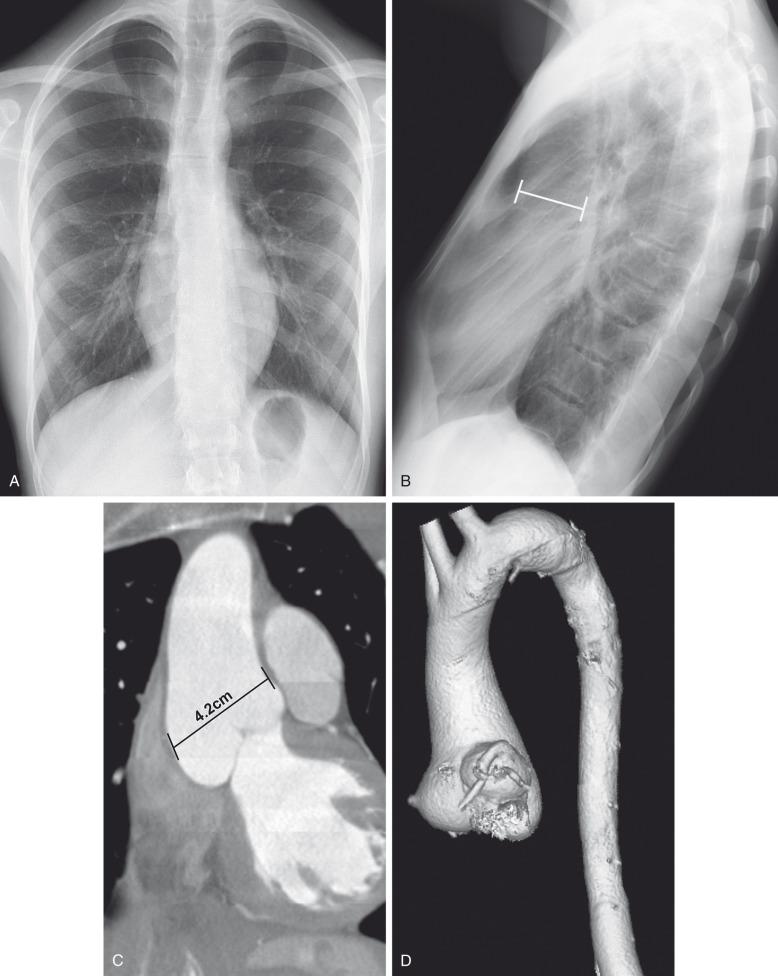
MVP affects 35% to 100% of patients with Marfan syndrome and is more common in women and children. More than 80% of children with Marfan syndrome have aortic root dilation, MVP, or both before age 18 years; aneurysms can be present even in young children. Symptoms of heart failure, usually related to valvular insufficiency, can develop in childhood or young adulthood.
On chest radiographs, a pectus deformity, kyphoscoliosis, and occasionally cystic lung disease may be present in addition to cardiomegaly and a dilated ascending aorta (see Fig. 78.4 ). Both MRI and transthoracic echocardiography are used for initial evaluation of the heart and aorta. Both have the advantage of being relatively noninvasive without exposing the patient to ionizing radiation. In Marfan syndrome, the dilated aorta/aneurysm typically is pear shaped because the most marked area of dilation is at the level of the sinuses of Valsalva (see Fig. 78.4 ).
Long-term surveillance of the aortic root is performed via MRA or CTA, which have the advantage of providing a global view of the entire aorta. Reformatted and three-dimensional techniques provide excellent visualization of the anatomy and accurate long-term measurements (see Fig. 78.4 ).
Measurement of the aortic root and assessment of aortic regurgitation are diagnostic criteria for Marfan syndrome. Affected individuals require long-term follow-up to identify progressive aortic root dilation and the appropriate timing for surgical intervention. In older children and adolescents, the incidence of complications such as dissection or rupture increases once the aortic root is larger than 5 cm in diameter. Cystic medial necrosis is the underlying pathologic abnormality of the aortic wall. A composite aortic valve graft replacement or aortic graft with a surgically resuspended native aortic valve are the most common surgical procedures. The latter has the advantage of avoiding the need for anticoagulation.
It is now recognized that fibrillin-1 is involved in regulating transforming growth factor–β (TGF-β), a cytokine pathway that affects cell performance; its increased activity is thought to cause many of the manifestations of Marfan syndrome. Several other TGF-β signalopathy vascular syndromes have been identified, including Loeys – Dietz syndrome and related disorders and autosomal recessive cutis laxa. Therapy using TGF-β antagonists (angiotensin receptor blockers) appears to offer promise.
Loeys – Dietz syndrome (LDS) is a rare connective tissue disorder associated with the dysregulation of TGF-β caused by mutations in the TGF-β receptor gene. Recently, mutations in the genes coding for the ligand TGFB2 and the first downstream effector SMAD3 were also associated with an LDS-like presentation. LDS is divided into two types. Type 1 patients have both craniofacial anomalies (e.g., bifid uvula, cleft palate, hypertelorism, craniosynostosis, and cervical spine instability) and widespread vascular anomalies. Type 2 patients generally have less severe manifestations; they may have a bifid uvula but usually do not have other craniofacial anomalies.
Vascular manifestations of LDS include elongated and tortuous large arteries, aneurysm formation, and stenoses ( Fig. 78.5 and and ). Abnormalities may be manifested in infancy. Dissection and aneurysm rupture occur commonly in persons with LDS at an earlier age and are associated with smaller-sized aneurysms than are typical for persons with Marfan syndrome. Although spontaneous visceral perforation may occur in patients with LDS (similar to patients with the vascular form of EDS), both the vascular and visceral lesions tend to do well with surgical intervention (unlike in patients with EDS).
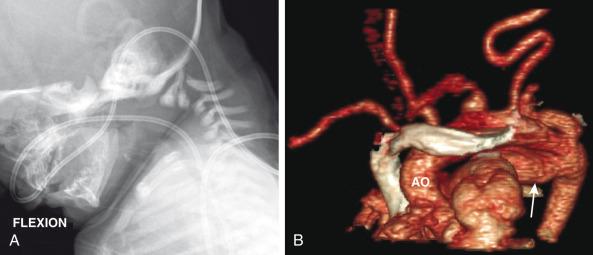
Neurocutaneous diseases affecting the cardiovascular system in children include neurofibromatosis type 1, tuberous sclerosis complex, and PHACES syndrome. Although not typically included in the neurocutaneous diseases, Noonan syndrome will be grouped here because of its genetic and phenotypic overlap with neurofibromatosis type 1.
Become a Clinical Tree membership for Full access and enjoy Unlimited articles
If you are a member. Log in here